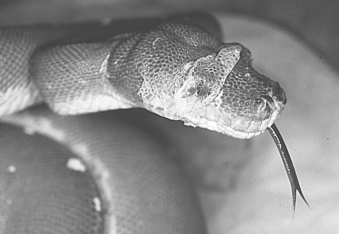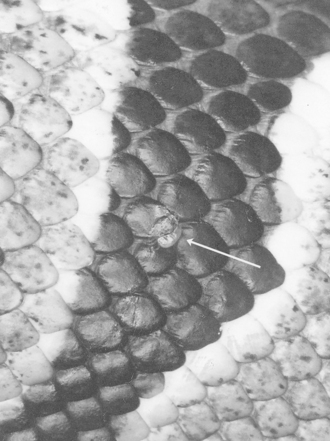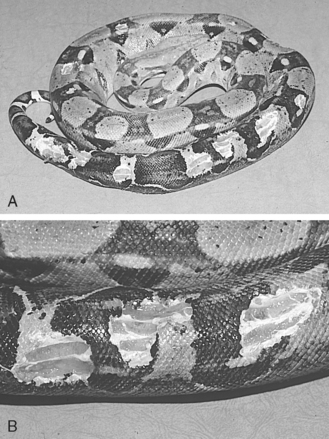Chapter 42 Diseases of the Integumentary System
SNAKES
Dysecdysis (Difficult or Incomplete Shed)
Difficulty shedding or failure to completely shed is a common problem in snakes kept in excessively dry environments (Fig. 42-1). Areas of old scar tissue, suture lines, or areas heavily parasitized may also fail to shed completely.

Figure 42-1 Dysecdysis, or abnormal shedding, has many causes.
(From Mader DR: Reptile medicine and surgery, ed 2, St. Louis, 2006, Saunders, by permission.)
Abscesses
Abscesses are one of the more common dermatologic problems seen in captive reptiles (see Color Plate 25). Bite wounds, cage trauma, prey bites, and attacks from cage mates can all result in infection with Gram-negative bacteria. Reptiles, like birds, form caseous abscesses; they contain inspissated or dry pus that must be removed surgically. Culture and sensitivity is necessary for proper treatment.
Parasites
The most common dermal parasites seen in snakes are the tick (Ixodes, Argasidae, Amblyomma) (Fig. 42-2) and the mite (Ophionyssus natricis; the snake mite). Numerous species inhabit reptiles, but the treatment is the same.

Figure 42-2 A hard-shelled tick under the scale of a ball python.
(From Mader DR: Reptile medicine and surgery, ed 2, St. Louis, 2006, Saunders, by permission.)
CLINICAL SIGNS
TREATMENT
TRAUMA
Prey Trauma
Trauma from prey occurs when a live animal is fed to the snake and ends up attacking the snake instead (Fig. 42-3). Wounds may be superficial, but snakes may be critically injured or even killed by larger prey with a desire to survive. This type of trauma can be prevented by feeding killed or stunned prey and carefully monitoring the feeding process until finished.

Figure 42-3 A, Multiple rat bite wounds in a boa constrictor. B, Close-up of some of the wounds on the same snake.
(From Mader DR: Reptile medicine and surgery, ed 2, St. Louis, 2006, Saunders, by permission.)



